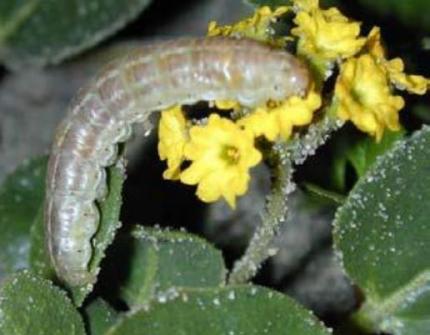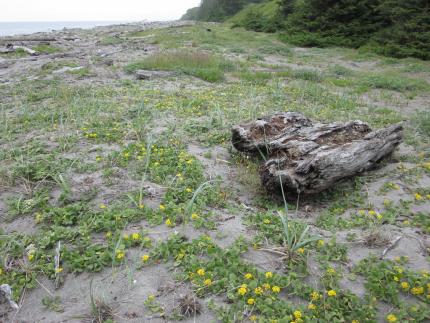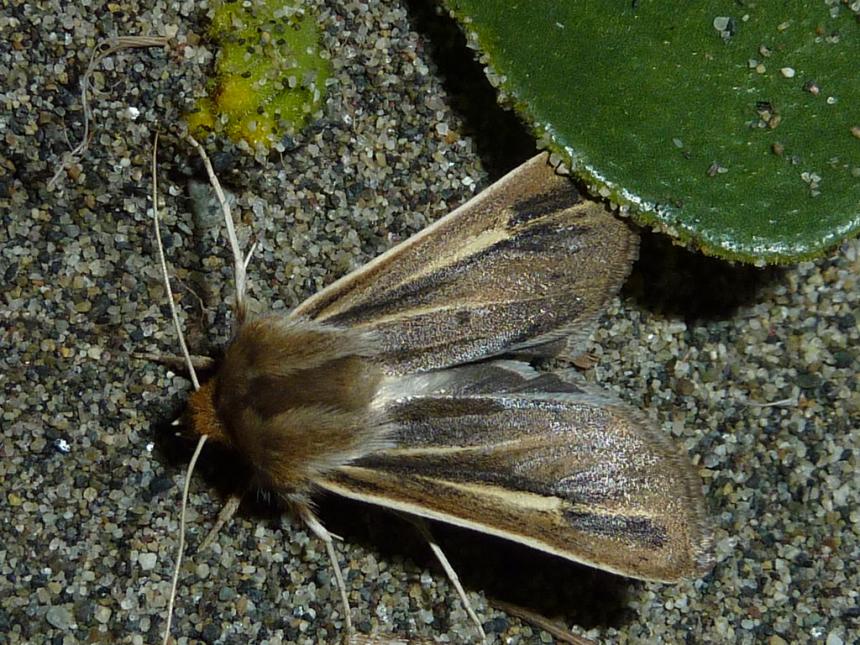Moderate
The sand-verbena moth was discovered on a few coastal beach sites on Vancouver Island, British Columbia, Canada, and Whidbey Island, in northwestern Washington, and described as a new species in 1995. This Copablepharon moth (Family Noctuidae) is imperiled due to its rare habitat types, small number of isolated populations, extremely limited range, and known threats to its habitats. They are habitat specialists that rely on loose, well-drained soils, especially sand.
Description and Range
Physical description
The sand-verbena moth has a wingspan averaging 1 1/2 inches in length. Adults are light beige to brown in color. The forewings are about 3/4 inches long with light yellow and black lines. Caterpillars are green with light striping; these larvae become brown when they are older.
Ecology and life history
Sand-verbena moths are restricted to active (non-stabilized) sandy sites, coastal sand beaches, and spits. These sand substrate habitats are rare in the Pacific Northwest, and in all cases are glacially derived. Wind action at these sites provides soil disturbance that supports native vegetation, such as the regionally rare yellow sand verbena (Abronia latifolia) (Family Nyctaginaceae)—the moth’s host plant.

Sand-verbena moths persist only on sites with large, dense, flowering patches of this plant species. Adult moths nectar primarily on it and females lay eggs directly on the flowers. Specialists of well-drained and sandy soils, the larvae burrow into the soil, emerging at night to feed on both the flowers and leaves.
Copablepharon moths complete a single life cycle annually (univoltine). They are sedentary, nocturnal moths that do not stray far from their restricted habitats and host plants.
Adults are present from mid-May through early July, and usually fly during dusk and early evening. Larvae are dormant, burrowed in the sand during winter, reemerging in early spring to feed and then pupate.
Geographic range

The distributions of these species are limited by their dependence on rare and highly restricted ecological systems. An endemic of Salish Sea sandy coastal sites, the sand verbena moth is known from only 10 sites; five on Vancouver Island, British Columbia, Canada, and five in Washington along the eastern edge of the Straits of Juan de Fuca (San Juan, Island, Jefferson, and Clallam Counties).
Sand-verbena moth is the only Copablepharon species known from west of the Cascades Mountains. Efforts have been made to locate additional populations within and outside of this area.
For a map showing range-wide conservation status and distribution, see NatureServe Explorer.
Climate vulnerability
Sensitivity to climate change
Moderate
The sand-verbena moth is primarily threatened by the loss of its host plant and open sandy coastal habitat as a result of encroaching vegetation (i.e,. invasive species). However, it may also exhibit sensitivity to a variety of climate and climate-driven changes, including enhanced coastal erosion, sea level rise and drought. Substantial sea level rise combined with increased storms could inundate sand-verbena moth larvae and habitat, but projected rates of rise alone through mid-century will likely not be enough to inundate all current habitat areas. Drought could lead to early senescence of yellow sand verbena, which would decrease food availability for both adults and larvae and affect annual population numbers. Yellow sand verbena is adapted to dry conditions, however, and can likely survive drought periods, so overall habitat area is not likely to decrease in response to drought.
Exposure to climate change
Moderate
- Increased invasive weeds
- Sea level rise
- Increased storm frequency and intensity
- Increased coastal erosion
- Drought
Conservation
The sand-verbena moth has received some study of its biology and life history from Pacific Northwest biologists.
Conservation Threats and Actions Needed
- Invasive and other problematic species
- Threat: Invasive plants, those currently here, and many yet to come in the future, out-compete natives and otherwise make habitat unsuitable.
- Action Needed: Using herbicide and mechanical methods to maintain open sand dunes.
- Climate change and severe weather
- Threat: Populations located adjacent to marine waters that are rising.
- Action Needed: Evaluate landscape and develop plan to increase habitat area and habitat heterogeneity in currently occupied sites and within occupied landscapes.
See the Climate vulnerability section for more information about the threats posed by climate change to the sand verbena moth.
Resources
References
COSEWIC, 2003. COSEWIC Assessment and Status Report on the Sand Verbena Moth Copablepharon fuscum in Canada. Committee on the Status of Endangered Wildlife in Canada. Ottawa. vii + 39 pp.
Combs, J.K. 2021. 2021 Sand-verbena moth (Copablepharon fuscum) and Host Plant (Abronia latifolia) Presence and Abundance Surveys in American Camp, San Juan Island National Historic Park. Prepared for the Nation Park Service, San Juan Island National Historic, Friday Harbor, WA. 14 pp.
Combs, J.K. 2020. 2020 Monitoring of Copablepharon fuscum (sand-verbena moth), a critically imperiled species, at Cattle Point NRCA. Prepared for the Washington Department of Natural Resources, Olympia, WA. 10 pp
Fleckenstein, J.W., J.K. Combs, A.S. Thorpe. 2018. Survey of Known and Potential Sites for the Sand-verbena Moth (Copablepharon fuscum). Washington Natural Heritage Program, Olympia, WA. 21 pp.
Fleckenstein, J.W., J.K. Combs, A.S. Thorpe. 2018. Monitoring protocols, habitat characteristics, and threat factors that may impact the survival of the Sand-verbena Moth (Copablepharon fuscum). Washington Natural Heritage Program, Olympia, WA. 39 pp.
Gibble, W. and J. Fleckenstein. 2013. Copablepharon fuscum (sand-verbena moth) and Abronia latifolia (yellow sand-verbena) Washington State surveys. Report prepared for US Fish and Wildlife Service. University of WA Botanic Gardens, Seattle and WA Department of Natural Resources, Olympia. Natural Heritage Report 2013- 02.
Hallock, L., R. Haugo, and R. Crawford. 2007. Conservation strategy for Washington inland sand dunes. WA Department of Natural Resources, Olympia. Natural Heritage Report 2007-05.
Lafontaine J. D., Crabo L. G., Fauske G. A. (2004) Genus Copablepharon. pp.146–180 in: Lafontaine (2004), Noctuoidea: Noctuidae (part) – Agrotini. In: Hodges RW (Ed.) The Moths of North America. Fascicle 27.1. The Wedge Entomological Research Foundation, Washington, 394 pp.
Pacific Northwest Moths. 2014. Western WA Univ. Bellingham. Available at: http://pnwmoths.biol.wwu.edu/
Troubridge, J. and L. Crabo. 1995. A new species of Copablepharon (Lepidoptera: Noctuidae) from British Columbia and Washington. J. Entomol. Soc. Brit. Columbia. 92: December. pp. 87-90.
USFWS. 2011. US Department of the Interior, Fish and Wildlife Service. Endangered and Threatened Wildlife and Plants; 90-Day Finding on a Petition to List the Sand Verbena Moth as Endangered or Threatened. Federal Register Vol. 76, No. 33: 9309-9318.
WildEarth Guardians. 2010. Petition to list the Sand Verbena Moth (Copablepharon fuscum) under the US Endangered Species Act. Submitted to the U.S Secretary of Interior February 4, 2010.
